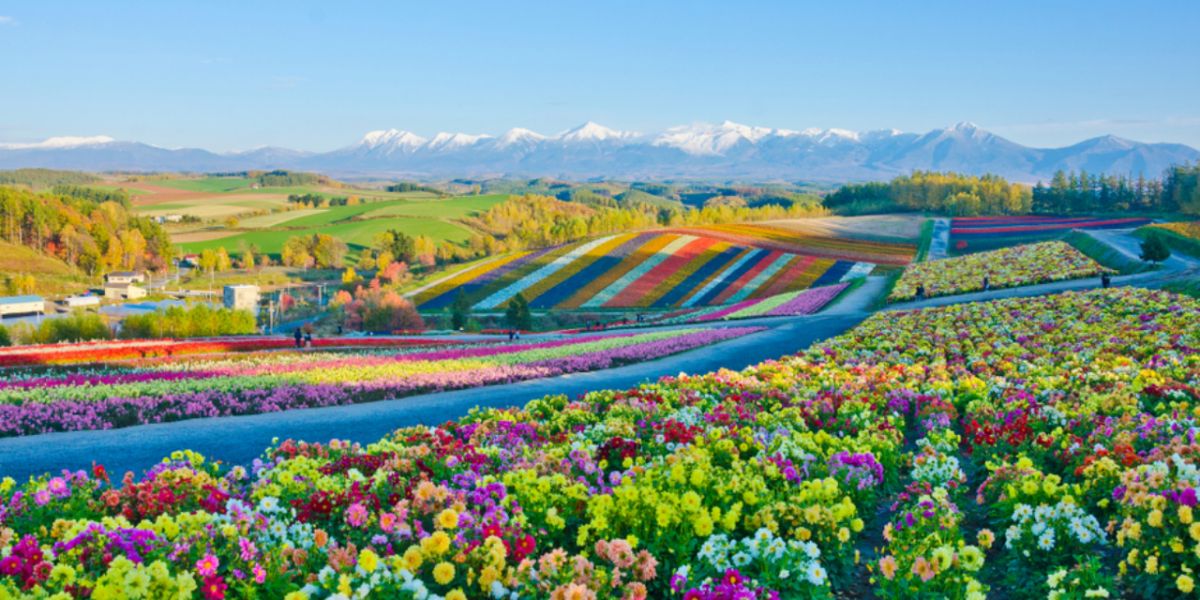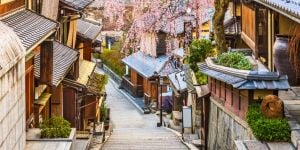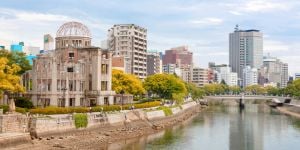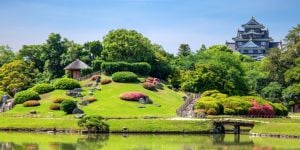
How about trying the Japanese adventure in Hokkaido? Far from Tokyo's effervescence, Japan's second largest island is the country's breadbasket. It is also a dynamic region that is massively investing in biotechnology to meet current and future challenges. What is the best way to find a job in Hokkaido? How do you integrate to enjoy your stay in Japan fully?
Mapping Hokkaido
Geography
The Japanese archipelago is composed of 5 main islands: Hokkaido in the North (it is the northernmost island of Japan), Honshu, Shikoku, Kyushu, and Okinawa in the South. In addition to these islands, the country counts many small and large islands, inhabited or not.
Japan counts 47 prefectures, which are grouped into more significant regions that include:
- Honshu, the largest island;
- Tôhoku;
- Kantô, home to the capital Tokyo;
- Chûbu;
- Kansai, where Osaka, Kyoto, Nara and Kobe are located;
- Chûgoku, which has Hiroshima as the main prefecture;
- Shikoku, the third island;
- Kyushu;
- Okinawa;
- Hokkaido, in the North.
Hokkaido literally means "way of the North Sea". The island has given its name to the region it harbors, just like Kyushu and Okinawa.
Many of Hokkaido's territory has been preserved in its natural state with its mountains and volcanoes, some of which are still active. The region is also an agricultural one, per excellence. The fauna and flora take advantage of the island's climate. The surrounding seas, namely the Okhotsk, the Sea of Japan, and the Pacific Ocean favor the development of fish farming.
Population
The island of Hokkaido has 5,111,691 people as of 2023. Most are located in the Southwestern city of Sapporo, the island's capital. Sapporo is home to about 1.88 million inhabitants and is far ahead of the two other cities with the largest populations in the region: Asahikawa lies a bit further North with 322,000 inhabitants, and Hakodate, in the extreme South, is home to 241,747 people. The other cities have between 170,000 and 110,000 inhabitants (source: Statistics Bureau of Japan).
The Ainu: The first inhabitants of Japan?
For decades, Japanese governments have tried to construct the story of a homogeneous people with a single identity, but Japan is a country of diverse ethnic origins. Ainu means "man", and the Ainu people have been present in Japan for several thousand years.
Historically, they originally lived on the island of Hokkaido, but nowadays, they are scattered all over Japan, and a little more than 24,000 are left. The reason behind this so-called ugly history is the colonization, discrimination, and displacement policies implemented by the government.
The Meiji era, which marked the Japanese restoration, promoted the empire's unification but consequently forbade the Ainu to speak their language and live by their culture. Nevertheless, the Ainu language was transmitted orally.
It was not until 1997 that a law on the Promotion of Ainu Culture and Dissemination and Enlightenment of Knowledge About Ainu Tradition was passed. In 2019, the Ainu were legally and officially recognized as an indigenous people of Japan – a law that caused a lot of commotion but failed to pronounce any apology or commitment to restore the rights of the Ainu.
How many foreigners live in Hokkaido?
By 2023, the number of foreigners residing in Sapporo was around 15,960, accounting for less than 1% of the total population. Over the past decade, the foreign community in Sapporo has been steadily growing. The population of foreign residents in Sapporo has risen from a mere 9,000 in 2013 (source: Sapporo Statistical Report).
The economy of Hokkaido
Hokkaido's nominal gross domestic product (GDP), representing the value added by production activities, stood at 19,725.6 billion yen in FY2020. However, the real economic growth rate experienced a decline of −5.2% during the same fiscal year.
Due to the impact of the pandemic and the rising prices of energy and food due to changes in the international situation, mainly related to Ukraine, the business environment surrounding Hokkaido's economy is a cause for concern, with worries about its continued severity.
Starting May 8, 2023, reviewing measures against infectious diseases, Hokkaido aims to address its challenges and focus on revitalizing the economy by leveraging the region's digital technology, energy, food, and tourism potential. Additionally, to contribute to energy and economic security, the "Basic Policy for Hokkaido Economic Revitalization" has been formulated, and this fiscal year will see the development of various measures based on five main pillars:
- Promotion of DX and GX that maximizes the potential of the main path;
- Further refinement and strategic promotion of the Hokkaido brand;
- Building a robust local economy and promoting future-oriented industry;
- Promotion of human resources development to support the future;
- Flexible response to changes in the socioeconomic situation.
Hokkaido's economy is based on four main pillars: agriculture, bio-industry and biotechnology, green industry, and tourism.
Agriculture
A quarter of all Japan's agricultural land is exploited in Hokkaido. The "Made in Hokkaido" label is a guarantee of quality. It sells well and is successfully exported. Farmers in Hokkaido own plots of land that are generally 13 times larger than in other regions and Japan's majority of farmers are found there.
The region, known for its rice and dairy production, is also the leading producer of beef cattle and dairy cows. Hokkaido, whose agricultural production is worth about 1250 billion yen, accounts for about 14% of Japan's total production and 23% of the country's fishing industry.
The food and agribusiness sector constitutes 34.9% of Hokkaido's market while being only 9% elsewhere in Japan. The green breadbasket of Japan is also more than 200% self-sufficient.
Bio-industry
The bio-industry represents all industrial activities that involve biotechnology, where the latter is the science of using living organisms or parts thereof to develop or create different products. It extends beyond the strict framework of research laboratories, with applications in the economy, health and food sectors, etc. All sectors can use biotechnology.
Hokkaido has entered the race for responsible and sustainable innovation. As early as 1985, it created the Hokkaido Biotechnology Information Club (HOBIC). In 2002, another organization was created, the Hokkaido Bio-Industry Association (HOBIA).
Facing demographic, environmental, and economic challenges, HOBIA promotes regional biodevelopment. Hokkaido and its abundant natural resources are a prime location for establishing bio-industries.
Many have established themselves in Sapporo, such as the giant Bio Do. More than 120 companies convened in Sapporo for the "Hokkaido Biotechnology Industry Cluster Forum".
Green energy
Hokkaido is also investing in the green industry. The region is again looking to make the most of its natural environment while preserving nature. Wind power and biomass are particularly well suited to Hokkaido's territory. The island could even provide, in the long run, at least a quarter of the country's renewable energy.
Following the March 11, 2011 tragedy, the authorities set up the "Hokkaido Energy Transition 100 Project", aiming to turn 100% of Hokkaido's energy green.
In July 2022, Hokkaido Electric Power, Green Power Investment, Nippon Steel Engineering, and Air Water Inc (gas supplier) set up a green hydrogen production center in Ishikari, North of Sapporo. The site is expected to be operational by March 2024. The plan is to supply energy locally and then sell it elsewhere in Japan.
Tourism
After Tokyo and Osaka, Hokkaido is Japan's third most important tourist region. Before COVID-19, it welcomed 35 million visitors (39 million for Osaka, 66 million for Tokyo). Tourism in Hokkaido relies heavily on nature, including its forests, hot springs, and farms. Festivals there remind visitors of the importance of respecting the seasons.
There, too, Sapporo acts as a showcase for Hokkaido. In 2018, it broke a record by welcoming 2.7 million visitors – an attractiveness that benefits local employment, namely in restaurants, hotels, farms, and museums. This is indeed one of the many ways the entire region's economy benefits from the fallout of tourism.
During the pandemic's peak, tourism to Japan, specifically Hokkaido, stopped for over two years.
The impact was evident during the 2023 Sapporo Snow Festival, held in Hokkaido, where visitors dropped significantly to approximately 1.75 million, marking the lowest attendance in over ten years, a significant decline from the 2.02 million visitors in 2022 before the pandemic.
However, there has been a gradual increase in arrivals since the government reintroduced visa-free travel for several countries and eliminated COVID-19 restrictions.
Sapporo, the economic heart of Hokkaido
Economy of Sapporo
Sapporo is the core business city of Hokkaido. It is in Sapporo that young people come for higher education. The city is also a major gateway to international trade, thanks to its air and sea ports.
The diversity of the job market in Sapporo attracts researchers, entrepreneurs, academics, start-ups, specialists in agribusiness, health professionals, etc.
Education accounts for nearly 10% of the market – scientific and technical services (8%), just ahead of specialized contractors (7.8%), hospital services (6.3%), and ambulance services (5.8%). Food represents nearly 6% of the market, ahead of real estate (5.33%). Next come administrative services, engineering and civil engineering, transport, construction, personal services, social assistance, etc. Sapporo has become a key back-office and customer support player in recent years. Call centers are multiplying in the city. Companies are also setting up their head offices here.
The demographic challenge
Japan is facing an unprecedented demographic challenge. The already alarming birth rate figures have fallen further with the health crisis. In Hokkaido, the median age is 48 years. The largest age groups are 45–59-year-olds (about 1.1 million) and 60–74-year-olds (just over 1 million). The Hokkaido population has steadily decreased after peaking in the 2000s, with about 5.7 million people between 2006 and 2010. Young people are leaving for Tokyo or elsewhere, and immigration appears to be the best solution for repopulating the territories.
Promoting multiculturalism in Hokkaido
In 2020, 934 people had left Monbetsu. Nine hundred and forty-seven people settled there, among them 232 foreigners. In January 2021, the city was home to 501 foreign residents, increasing to about 200 people over 5 years. Most of them work in the agricultural and fish farming sectors.
In 2021, the city hosted 60 technical trainees from China, Vietnam, and Thailand to celebrate Christmas and the recent opening of a center for foreign trainees.
In February 2022, the Japan International Cooperation Agency (JICA) and Hokkaido Prefecture signed an agreement to promote "multicultural coexistence". According to JICA, the number of foreigners settling in the prefecture is growing faster in Hokkaido than in other regions of Japan. At the same time, the population curve is falling more quickly in Hokkaido than elsewhere. For JICA, Hokkaido must take another step towards immigration and reach out to foreign residents to promote their integration.
Startup ecosystem in Hokkaido
Hokkaido is quickly becoming a hub for entrepreneurial innovation in Asia. Hokkaido actively fosters a vibrant start-up ecosystem that maintains its distinct identity by leveraging its strategic location.
Four key factors drive the growth of this ecosystem:
- proactive government initiatives that remove bureaucratic obstacles and encourage open innovation;
- a strong support network consisting of accelerators and networking events;
- collaborative partnerships with universities and research institutes in Hokkaido;
- flexible funding opportunities tailored to the unique needs of ventures.
Together, these measures are paving the way for Hokkaido to shine as a center of technological advancement and entrepreneurship in the region. With this support from the government, we expect to see more and more new businesses created with more job opportunities for both Japanese and foreign nationals.
Finding a job in Hokkaido
Are you a professional in biotechnology, agriculture, or fish farming? If so, you should definitely move to Hokkaido. As mentioned earlier in this article, the prefecture is, at the same time, the green breadbasket of Japan and a place where much investment in research to preserve the environment is being made. Therefore, jobs in research, engineering, agriculture, and agribusiness, such as engineer, agronomist, farmer, or qualified technician, can be yours, provided you speak Japanese.
Careers in agriculture: The Tokachi example
The region, located Southeast of Hokkaido, is one of the few flat areas of the island. It is mainly made up of farms and is nicknamed "the green granary of Japan". All kinds of crops are grown in Tokachi, from wheat to potatoes, corn, rapeseed, sugar beets, Azuki beans, and soybeans, which are sold all over Japan. Tokachi has fertile land and an ideal climate for crops.
If you want to work in the agricultural sector in Hokkaido, the following opportunities exist in Tokachi: farmer, crop manager, farm machinery operator, agricultural consultant, plant experimentation engineer, market gardener, farm equipment mechanic, forestry worker, marketing specialist, sales representative, communication officer. These jobs are wide-ranging and go beyond the strict land cultivation and breeding framework.
Engineering
The same diversity of jobs exists in engineering. One can be an electrical designer, automation engineer, mechanical project manager, electrical foreman, climatic engineer, energy efficiency engineer, or hydraulic engineer in Hokkaido. These cutting-edge jobs respond to the island's investments in sustainable innovation, but here again, you will first need to master the Japanese language.
Teaching
Teaching professions are also much in demand in Hokkaido, mainly in Sapporo. Be careful, however. These are not just small jobs where one teaches how to sustain a conversation in a cafe (for example). You will need a university degree to be able to teach in Japan.
The brewing industry
Like in the rest of Japan, Sapporo is known abroad for its beer. Indeed, Sapporo beer is one of the three most consumed beers in the archipelago (with Asahi and Kirin). Its success has not been compromised since 1876, and it is constantly innovating. For example, to fight pollution and reduce its costs, Sapporo Breweries recovers the waste from the brewing process to make jeans. So, the brewery does not only produce new beer recipes but also eco-friendly jeans in partnership with the manufacturer Shima Denim Works – a technological feat that has already seduced several thousand customers.
Tips for landing a job in Hokkaido
Learn Japanese
This time, dodging won't be an option. One may think that English is enough to survive an experience in Tokyo or Osaka, but living in Hokkaido without knowing the language will distract you from everyday life. Finding a job will be much more complicated. When you understand how difficult it already is to find work in Tokyo or any other big Japanese city, you naturally need to put all the chances on your side.
Learn Japanese before you arrive in Hokkaido, or at least have the basics to make yourself understood. Improve your Japanese when you arrive, even if it means spending a year or more in a language school.
Learn the Japanese culture
Take the time to discover your new city, to venture into the countryside. Take an interest in the Ainu culture. In July 2020, Upopoy, the national Ainu Museum, opened in Shiraoi, Southwest Hokkaido.
Meet the locals
Upon your relocation to Hokkaido, take the time to develop your professional and social networks. Take part in the activities of your new city, and join clubs and associations. Meet the locals and allow them to share experiences with you.
Useful links:
Bio Do, bio-industry company (in Japanese)
Guide to looking for work in Sapporo
Living and working in Hokkaido (in Japanese)
Working in Hokkaido: job offers and testimonials (in Japanese)
Working in Tokachi – job offers
We do our best to provide accurate and up to date information. However, if you have noticed any inaccuracies in this article, please let us know in the comments section below.








